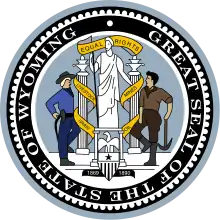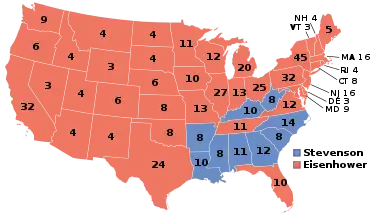1952 United States presidential election in Wyoming
The 1952 United States presidential election in Wyoming took place on November 4, 1952, as part of the 1952 United States presidential election. State voters chose three representatives, or electors, to the Electoral College, who voted for president and vice president.[3]
| ||||||||||||||||||||||||||
All 3 Wyoming votes to the Electoral College | ||||||||||||||||||||||||||
|---|---|---|---|---|---|---|---|---|---|---|---|---|---|---|---|---|---|---|---|---|---|---|---|---|---|---|
| ||||||||||||||||||||||||||
 County Results
| ||||||||||||||||||||||||||
| ||||||||||||||||||||||||||
| Elections in Wyoming |
|---|
 |
Wyoming was won by the Republican candidate, Columbia University President Dwight D. Eisenhower from New York, running with California Senator Richard Nixon, with 62.71 percent of the popular vote, against the Democratic candidate, Adlai Stevenson from Illinois, running with Alabama Senator John Sparkman, with 38.93 percent of the popular vote, a margin of victory of 25.6%. Eisenhower was able to easily carry the state despite the fact that it had voted for Harry Truman 4 years earlier in 1948, with the state trending to the right by almost 30 points in this election. Wyoming weighed in as 14.7% more Republican than the rest of the nation.
Eisenhowever flipped 9 counties that had previously gone Democratic in 1948, those being: Uinta, Sheridan, Platte, Natrona, Lincoln, Laramie, Hot Springs, Carbon, and Albany. Stevenson only managed to win one county, with that being the heavily unionized Sweetwater, which no Republican had won since Warren Harding in 1920. With the Republican victory in this race and the next two consecutive elections, Wyoming would begin it's transition into a Republican stronghold, only voting for the Democratic presidential nominee one more time, in 1964. In fact, since 1964, Democrats haven't even managed to crack 40% of the statewide vote in an election.[4]
Due to Harry Truman's low approval ratings, Stevenson largely avoided being tied to his administrations, and instead opted to campaign on his support for the popular New Deal, a serious of federal programs that attempted to fight poverty during The Great Depression, and even went as far as to say that should Republicans retake the presidency, the country would enter another depression. He also attempted to exploit the rift between the Republican Party's moderate and conservative factions, saying that the GOP had no unifying vision for America.[5] He also attempted to tie Eisenhower to controversial senators such as Joseph McCarthy from Wisconsin and William Jenner from Indiana, who Democrats said made reckless and dangerous claims about communist influence within the government through various congressional investigations.[6]
Eisenhower had served as The Supreme Commander of The Allied Expeditionary Force during World War II, being instrumental in leading the Allies to victory, which made him immensely popular both at home and abroad. He attacked Truman's handling of the Korean War and broader Cold War, as well as claiming that Soviet spies had infiltrated the American government. In addition, the Eisenhower campaign made a major effort to reach out to women voters, becoming one of the first presidential campaigns to do so. His television ads discussed topics such as education, inflation, and ending the Korean War, which he believed would appeal to women voters, and also made a point to hire as many female campaign workers as possible, who made phone calls to likely Republican voters, distributed "Ike" buttons, and threw parties for the GOP in their neighborhoods. This would ultimately culminate in Eisenhower carrying a solid majority of women voters.[7]
With his victory, Eisenhowever finished the slow rebounding of Republican strength that Thomas Dewey had attempted to enact in 1944 and 1948, with the traditionally Republican Northeast and made major gains throughout the Midwest and even the traditionally Democratic South, putting an end to 20 years of executive Democratic rule, and Republicans regained control of The Senate and The House for the first time since the 1946 elections.
Results
| Party | Candidate | Votes | % | |
|---|---|---|---|---|
| Republican | Dwight D. Eisenhower | 81,049 | 62.71% | |
| Democratic | Adlai Stevenson | 47,934 | 38.93% | |
| Prohibition | Stuart Hamblen | 194 | 0.15% | |
| Socialist | Darlington Hoopes | 40 | 0.03% | |
| Labor | Eric Hass | 36 | 0.03% | |
| Total votes | 129,251 | 100.00% | ||
Results by county
| County | Dwight David Eisenhower Republican |
Adlai Stevenson II Democratic |
Carl Stuart Hamblen[8] Prohibition |
Darlington Hoopes[8] Socialist |
Eric Hass[8] Labor |
Margin | Total votes cast[9] | ||||||
|---|---|---|---|---|---|---|---|---|---|---|---|---|---|
| # | % | # | % | # | % | # | % | # | % | # | % | ||
| Albany | 4,560 | 59.59% | 3,082 | 40.28% | 6 | 0.08% | 4 | 0.05% | 0 | 0.00% | 1,478 | 19.32% | 7,652 |
| Big Horn | 3,859 | 68.67% | 1,755 | 31.23% | 5 | 0.09% | 1 | 0.02% | 0 | 0.00% | 2,104 | 37.44% | 5,620 |
| Campbell | 1,823 | 73.10% | 666 | 26.70% | 4 | 0.16% | 1 | 0.04% | 0 | 0.00% | 1,157 | 46.39% | 2,494 |
| Carbon | 3,403 | 51.09% | 3,242 | 48.67% | 5 | 0.08% | 2 | 0.03% | 9 | 0.14% | 161 | 2.42% | 6,661 |
| Converse | 2,056 | 70.51% | 850 | 29.15% | 10 | 0.34% | 0 | 0.00% | 0 | 0.00% | 1,206 | 41.36% | 2,916 |
| Crook | 1,734 | 79.80% | 423 | 19.47% | 10 | 0.46% | 3 | 0.14% | 3 | 0.14% | 1,311 | 60.33% | 2,173 |
| Fremont | 5,881 | 72.94% | 2,161 | 26.80% | 17 | 0.21% | 3 | 0.04% | 1 | 0.01% | 3,720 | 46.14% | 8,063 |
| Goshen | 3,396 | 67.14% | 1,648 | 32.58% | 9 | 0.18% | 4 | 0.08% | 1 | 0.02% | 1,748 | 34.56% | 5,058 |
| Hot Springs | 1,573 | 64.68% | 856 | 35.20% | 2 | 0.08% | 1 | 0.04% | 0 | 0.00% | 717 | 29.48% | 2,432 |
| Johnson | 1,980 | 78.45% | 543 | 21.51% | 1 | 0.04% | 0 | 0.00% | 0 | 0.00% | 1,437 | 56.93% | 2,524 |
| Laramie | 10,785 | 56.61% | 8,187 | 42.97% | 59 | 0.31% | 12 | 0.06% | 8 | 0.04% | 2,598 | 13.64% | 19,051 |
| Lincoln | 2,321 | 57.59% | 1,709 | 42.41% | 0 | 0.00% | 0 | 0.00% | 0 | 0.00% | 612 | 15.19% | 4,030 |
| Natrona | 10,663 | 63.87% | 6,021 | 36.06% | 10 | 0.06% | 1 | 0.01% | 0 | 0.00% | 4,642 | 27.80% | 16,695 |
| Niobrara | 1,652 | 73.13% | 588 | 26.03% | 18 | 0.80% | 1 | 0.04% | 0 | 0.00% | 1,064 | 47.10% | 2,259 |
| Park | 5,067 | 70.62% | 2,084 | 29.05% | 19 | 0.26% | 3 | 0.04% | 2 | 0.03% | 2,983 | 41.57% | 7,175 |
| Platte | 2,148 | 60.95% | 1,364 | 38.71% | 5 | 0.14% | 5 | 0.14% | 2 | 0.06% | 784 | 22.25% | 3,524 |
| Sheridan | 6,522 | 67.55% | 3,124 | 32.36% | 5 | 0.05% | 4 | 0.04% | 0 | 0.00% | 3,398 | 35.19% | 9,655 |
| Sublette | 1,013 | 74.54% | 344 | 25.31% | 1 | 0.07% | 1 | 0.07% | 0 | 0.00% | 669 | 49.23% | 1,359 |
| Sweetwater | 3,567 | 38.05% | 5,807 | 61.95% | 0 | 0.00% | 0 | 0.00% | 0 | 0.00% | -2,240 | -23.90% | 9,374 |
| Teton | 1,166 | 78.62% | 317 | 21.38% | 0 | 0.00% | 0 | 0.00% | 0 | 0.00% | 849 | 57.25% | 1,483 |
| Uinta | 1,801 | 55.45% | 1,444 | 44.46% | 1 | 0.03% | 1 | 0.03% | 1 | 0.03% | 357 | 10.99% | 3,248 |
| Washakie | 2,148 | 70.82% | 880 | 29.01% | 4 | 0.13% | 1 | 0.03% | 0 | 0.00% | 1,268 | 41.81% | 3,033 |
| Weston | 1,931 | 69.61% | 839 | 30.25% | 3 | 0.11% | 1 | 0.04% | 0 | 0.00% | 1,092 | 39.37% | 2,774 |
| Totals | 81,049 | 62.71% | 47,934 | 37.09% | 194 | 0.15% | 40 | 0.03% | 36 | 0.03% | 33,115 | 25.62% | 129,253 |
References
- "United States Presidential election of 1952 - Encyclopædia Britannica". Retrieved July 25, 2017.
- "U.S. presidential election, 1952". Facts on File. Archived from the original on October 29, 2013. Retrieved October 24, 2013.
Eisenhower, born in Texas, considered a resident of New York, and headquartered at the time in Paris, finally decided to run for the Republican nomination
- "1952 Presidential Election Results – Wyoming". Retrieved May 31, 2023.
- "How the red and blue map evolved over the past century". America Magazine. June 29, 2016. Retrieved May 31, 2023.
- (Abels, p. 192)
- (Halberstam, p. 234)
- "1952 Eisenhower v. Stevenson". April 20, 2009. Archived from the original on April 20, 2009. Retrieved May 31, 2023.
- Our Campaigns; WY US President Race, November 04, 1952
- Scammon, Richard M. (compiler); America at the Polls: A Handbook of Presidential Election Statistics 1920-1964; p. 459 ISBN 0405077114


